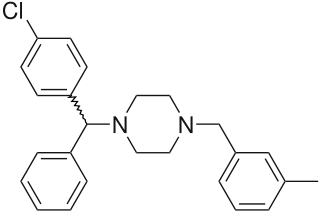Ethylenediamine (abbreviated as en when a ligand) is the organic compound with the formula C2H4(NH2)2. This colorless liquid with an ammonia-like odor is a basic amine. It is a widely used building block in chemical synthesis, with approximately 500,000 tonnes produced in 1998. Ethylenediamine is the first member of the so-called polyethylene amines.

Flunarizine, sold under the brand name Sibelium among others, is a drug classified as a calcium antagonist which is used for various indications. It is not available by prescription in the United States or Japan. The drug was discovered at Janssen Pharmaceutica (R14950) in 1968.

Oxatomide, sold under the brand name Tinset among others, is a first-generation antihistamine of the diphenylmethylpiperazine family which is marketed in Europe, Japan, and a number of other countries. It was discovered at Janssen Pharmaceutica in 1975. Oxatomide lacks any anticholinergic effects. In addition to its H1 receptor antagonism, it also possesses antiserotonergic activity similarly to hydroxyzine.

Chlorcyclizine is a first-generation antihistamine of the diphenylmethylpiperazine group marketed in the United States and certain other countries. It is used primarily to treat allergy symptoms such as rhinitis, urticaria, and pruritus, and may also be used as an antiemetic. In addition to its antihistamine effects, chlorcyclizine also has some anticholinergic, antiserotonergic, and local anesthetic properties. It also has been studied as a potential treatment for various flaviviruses like Hepatitis C and Zika Virus.

Lidoflazine is a piperazine calcium channel blocker. It is a coronary vasodilator with some antiarrhythmic action. Lidoflazine was discovered at Janssen Pharmaceutica in 1964.

Antrafenine (Stakane) is a phenylpiperazine derivative drug invented in 1979. It acts as an analgesic and anti-inflammatory drug with similar efficacy to naproxen, but is not widely used as it has largely been replaced by newer drugs.
Fipexide is a psychoactive drug of the piperazine chemical class which was developed in Italy in 1983. It was used as a nootropic drug in Italy and France, mainly for the treatment of senile dementia, but is no longer in common use due to the occurrence of rare adverse drug reactions including fever and hepatitis. Fipexide is similar in action to other nootropic drugs such as piracetam and has a few similarities in chemical structure to centrophenoxine. Chemically, it is an amide union of parachlorophenoxyacetate and methylenedioxybenzylpiperazine (MDBZP), and has been shown to metabolize to the latter, which plays a significant role in its effects.

Azaperone is a pyridinylpiperazine and butyrophenone neuroleptic drug with sedative and antiemetic effects, which is used mainly as a tranquilizer in veterinary medicine. It is uncommonly used in humans as an antipsychotic drug.

Tandospirone is an anxiolytic and antidepressant drug used in China and Japan, where it is marketed by Dainippon Sumitomo Pharma. It is a member of the azapirone class of drugs and is closely related to other azapirones like buspirone and gepirone.

Bromazine, sold under the brand names Ambodryl, Ambrodil, and Deserol among others, also known as bromodiphenhydramine, is an antihistamine and anticholinergic medication of the ethanolamine class. It is an analogue of diphenhydramine with a bromine substitution on one of the phenyl rings.

Clemizole is an H1 antagonist.

Ateviridine is a non-nucleoside reverse transcriptase inhibitor that has been studied for the treatment of HIV.

Dixyrazine, also known as dixypazin (oxalate), sold under the brand names Ansiolene, Esocalm, Esucos, Metronal, and Roscal, is a typical antipsychotic of the phenothiazine group described as a neuroleptic and antihistamine. It was first introduced in Germany in 1969. It is used as a neuroleptic, anxiolytic, and antihistamine in doses between 12.5 and 75 mg a day.

Thiopropazate is a typical antipsychotic of the phenothiazine class. It is a prodrug to perphenazine.

Meclizine, sold under the brand name Bonine, among others, is an antihistamine used to treat motion sickness and dizziness (vertigo). It is taken by mouth. Effects generally begin in an hour and last for up to a day.

Cyanodothiepin (developmental code name BTS-56424) is a tricyclic antidepressant (TCA) acting as a potent and highly selective (over norepinephrine and dopamine uptake) inhibitor of the reuptake of serotonin that was never marketed. It also has moderate affinity for the muscarinic acetylcholine receptors and weak/negligible affinity for the α1-adrenergic, 5-HT2A, D1, and D2 receptors; the H1 receptor has not been assayed, but cyanodothiepin is less sedating than the related drug cianopramine, suggesting that its antihistamine activity is not as pronounced as other TCAs. Cyanodothiepin is active in the forced swimming test (FST), implying that it may possess antidepressant properties in humans. However, it is only weakly active compared to cianopramine and imipramine in monoamine depletion-based tests of antidepressant potential.

Mazapertine (RWJ-37796) is an antipsychotic agent that was developed by Johnson & Johnson but never marketed. It exerts its pharmacological effect through affinity for dopamine D2, serotonin 5-HT1A, and α1-adrenergic receptors.
2,5-Diketopiperazine is an organic compound with the formula (NHCH2C(O))2. The compound features a six-membered ring containing two amide groups at opposite positions in the ring. It was first compound containing a peptide bond to be characterized by X-ray crystallography in 1938. It is the parent of a large class of 2,5-Diketopiperazines (2,5-DKPs) with the formula (NHCH2(R)C(O))2 (R = H, CH3, etc.). They are ubiquitous peptide in nature. They are often found in fermentation broths and yeast cultures as well as embedded in larger more complex architectures in a variety of natural products as well as several drugs. In addition, they are often produced as degradation products of polypeptides, especially in processed foods and beverages. They have also been identified in the contents of comets.

KMUP-1 is a xanthine derivative with phosphodiesterase inhibitor activity.

Diphenpipenol is an opioid analgesic drug invented in the 1970s by Dainippon Pharmaceutical Co. It is chemically a 1-substituted-4-(1,2-diphenylethyl)piperazine derivative related to compounds such as MT-45 and AD-1211, but diphenpipenol is the most potent compound in the series, with the more active (S) enantiomer being around 105 times the potency of morphine in animal studies. This makes it a similar strength to fentanyl and its analogues, and consequently diphenpipenol can be expected to pose a significant risk of producing life-threatening respiratory depression, as well as other typical opioid side effects such as sedation, itching, nausea and vomiting.


















